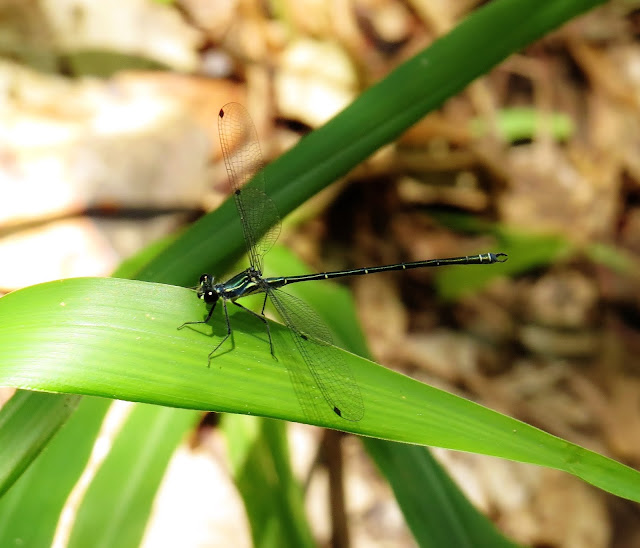 |
| Chequered swallowtails are often found resting in long grass. |
 |
| Featured areas: (1) Suburban Keperra, (2) Grovely Sports Ground, (3) Kindlinen Place, (4) Keperra Bushland Reserve, and (5) Dash Street Park. Image courtesy of Google Maps. |
Keperra was given its name by the local Yuggera people, whose name for the place ('Kipper') referred to its use as a venue for initiation ceremonies. Several bora-rings were once known in the area, but sadly, these places have since been destroyed by development.
Both the golf course in the north and quarry to the south of Samford Road are likely to provide refuge to a variety of wildlife, but accessing either of these sites is difficult. The Keperra Picnic Grounds fall just outside of the official suburb boundary, and are subsequently not featured below.
 |
| Aramac Street. |
Keperra's transition from military camp to residential area began in the 1950s, and as such, the gardens and streetscapes in this suburb are a generous size and home to many mature trees. Walking down Aramac Street, I was impressed by leafy gardens with fully-grown natives like the golden penda (Xanthostemon chrysanthus) and macaranga (Macaranga tanarius). One of the most common street trees in the area is the leopard tree (Libidibia ferrea), a Brazilian species that the Brisbane City Council seems to be rather enamoured by. On the roundabouts along Dawson Parade, kauri pines (Agathis robusta) are maturing nicely. All this greenery lends itself to a healthy birdlife in the suburb, with the calls of laughing kookaburras (Dacelo novaeguineae), grey butcherbirds (Cracticus torquatus) and pied currawongs (Strepera graculina) filling the air.
 |
| A rarely seen side to one of Brisbane's most-loved waterways, Kedron Brook. |
2. Grovely Sports Grounds
The eastern part of Keperra is known locally as 'Grovely', though this is not an official suburb designation. A concrete pathway runs alongside Kedron Brook through much of this area, starting at the Grovely Sports Grounds. Access to the water is limited due to the steep banks and dense riparian vegetation, which unfortunately consists mostly of pest species like the camphor laurel (Cinnamomum camphora). The opportunity to enjoy some peace near the water should be taken however; eastern water dragons (Intellagama lesueurii) and common flatwings (Austroargiolestes icteromelas) are all but guaranteed, and platypus (Ornithorhynchus anatinus) sightings are possible.
 |
| Unlike other damselflies, common flatwings lay their wings horizontally out to the side when resting. |
3. Kindlinen Place
 |
| Great egret (Ardea modesta). |
Despite the narrow nature of the waterway running through this park, a number of waterbirds make use of it. Pacific black ducks (Anas superciliosa), dusky moorhens (Gallinula tenebrosa), egrets and herons frequent the area, thanks to an abundance of water-weeds and fish.
Swamp box (Lophostemon suaveolens) and forest red gums (Eucalyptus tereticornis) are scattered through the parkland, the latter being an important tree for koalas (Phascolarctos cinereus) moving through the area. An impressive rubber fig (Ficus elastica) grows near Samford Road, though it's a shame this Indian species was chosen for planting over our local superstar, the Moreton Bay fig (Ficus macrophylla).
 |
| Rubber figs have larger leaves (<30cm) than our Australian figs. |
 |
| Pale-vented bush-hen; Photo by Greg Roberts, Sunshine Coast Birds. |
Protecting a substantial portion of the Keperra escarpment, this reserve is home to lots of interesting wildlife, but be warned—the main walking track is very steep and in poor condition. If that hasn't put you off, the 2.5km circuit is best accessed from a small gate off Cobalt Street, and the views near the top are lovely in some places. You don't have to head too far into the reserve to have good wildlife sightings either; immediately upon entering the reserve, I was lucky to find a pair of pale-vented bush-hens (Amaurornis molucca) skulking along the trail.
The erosion-prone hillside consists of a gravel and rock substrate, upon which a variety of bee-flies (Bombyliidae family) and ants can be observed going about their business. The abundance of the latter make this one of the closest places to the Brisbane CBD where echidnas (Tachyglossus aculeatus) are resident. It is also a great location to see butterflies: clearwing (Cressida cressida), orchard (Papilio aegeus) and chequered swallowtails (P. demoleus) are all possible, and monarchs (Danaus plexippus) fill the grassy areas with their vibrant colour.
 |
| Striated Pardalote. |
 |
| Looking down the steep trail at Keperra Bushland Reserve. |
 |
| Straw-necked ibis and masked lapwing. |
This open parkland features an off-leash dog area and children's playground, around which three species of paperbark trees have been planted. The broad-leaved paperbark (Melaleuca quinquenervia) is our familiar local species, with elliptical leaves and cream flowers. As its name suggests, the red-flowering paperbark (M. viridiflora) can be told apart from the former tree by its red flowers, and the weeping paperbark (M. leucadendra) has longer, drooping leaves and cream flowers. Large flocks of rainbow (Trichoglossus moluccanus) and scaly-breasted lorikeets (T. chlorolepidotus) utilise these trees as a source of nectar, and shelter in the forest red gums growing near Keperra Train Station. Other birds in the park include sulphur-crested cockatoos (Cacatua galerita), masked lapwings (Vanellus miles) and straw-necked ibis (Threskiornis spinicollis).
 |
| Reptiles including the elegant snake-eyed skink (Cryptoblepharus pulcher) frequent the rock-strewn hillsides of Keperra Bushland Reserve. |
Comments
Post a Comment